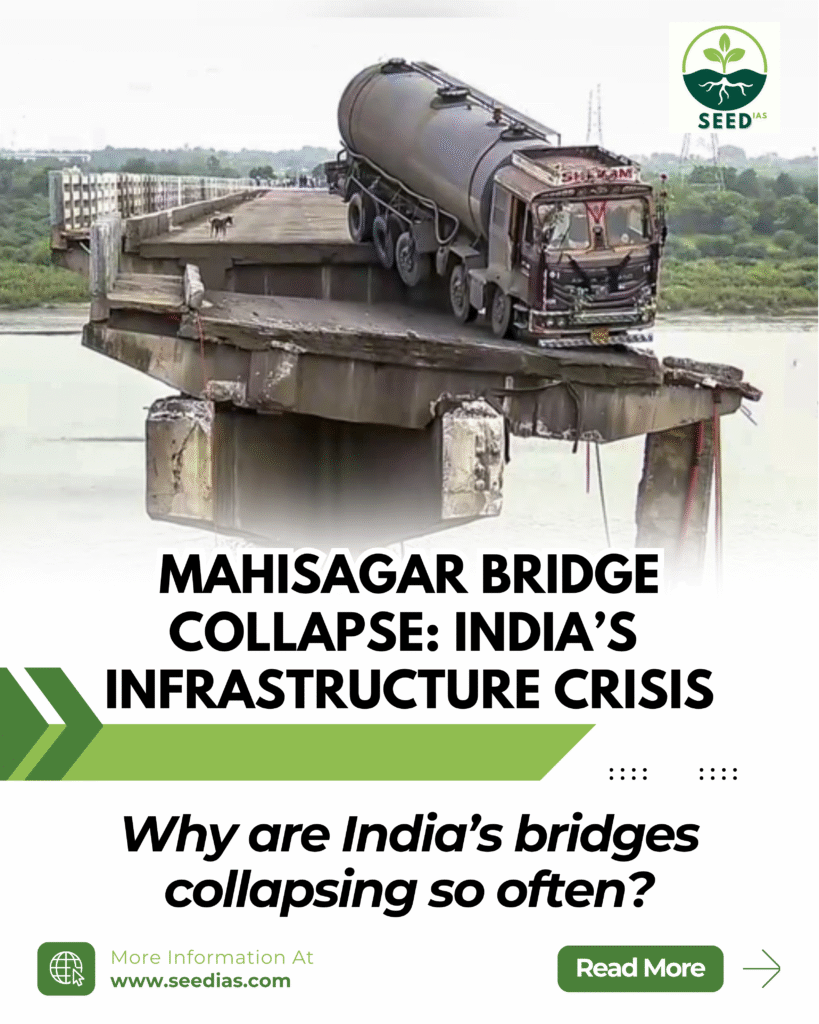Why in News?
The collapse of the Mahisagar River Bridge in Vadodara, Gujarat, has claimed 20 lives, raising serious concerns about the structural integrity of India’s infrastructure. This incident follows a series of similar bridge collapses across India, exposing recurring systemic failures.
Key Terms/Concepts
| Term | Explanation |
|---|---|
| Structural Failure | Breakdown of a structure due to design flaws, poor materials, or stress beyond limits. |
| Overloading | Excess weight beyond the bridge’s designed capacity. A leading cause of collapse. |
| Ghost Project | Projects shown as completed on paper but non-existent or illegally built. |
| Bridge Management System (BMS) | A tool to monitor, inspect, and maintain bridges regularly. |
| Parvatmala Pariyojana | Government initiative to develop ropeways in hilly and congested urban areas. |
Recent Infrastructure Collapses Across India
| State | Incident |
|---|---|
| Gujarat | 2022 Morbi suspension bridge collapse killed 135 people. |
| Maharashtra | Palava Bridge shut 2 hours after opening due to cracks; Pune’s pedestrian bridge collapsed due to overcrowding. |
| Assam | Harang Bridge collapsed in June 2025 due to overloaded trucks and heavy rainfall. |
| Madhya Pradesh | Bhopal’s Aishbagh rail overbridge criticized for dangerous 90-degree turn. |
| Bihar | In 2024, 12 bridges collapsed in 20 days. In 2025, Munger’s Bichli Pul collapse cut off 80,000 people. |
Reasons Behind India’s Infrastructure Failures
| Factor | Explanation |
|---|---|
| Corruption & Substandard Materials | Political-criminal nexus, bribe-driven contracts, poor-quality construction materials. |
| Ghost Projects & Fund Misuse | Fake or illegal bridges built for land scams, as seen in Bihar. |
| Poor Maintenance & Overloading | Old bridges left uninspected; unregulated heavy vehicle movement increases stress. |
| Engineering Flaws | Lack of expert design review, unsafe curves or alignment (e.g., Bhopal’s Aishbagh bridge). |
| Lack of Accountability | No criminal action after collapses like Morbi, Mahisagar; weak institutional response. |
| Weak Safety Regulation | Absence of mandatory bridge audits and lifecycle safety standards. |
| Climate and Environmental Factors | River erosion, floods (especially in Assam, Bihar), unaccounted during construction. |
| Unplanned Urbanization | Sudden rise in vehicle load and poor urban planning stress existing infrastructure. |
| Political Interference | Rushed inaugurations of incomplete projects; ignoring technical approvals. |
| Centre-State Mismanagement | Coordination failure, fund delays, political blame games stall repair or reconstruction. |
Current State of India’s Infrastructure
| Sector | Status |
|---|---|
| Roads & Highways | India has world’s 2nd largest road network (1.46 lakh km of National Highways as of 2024). |
| Railways | First bullet train project underway; fewer fatal accidents than previous decade. |
| Civil Aviation | Now 3rd largest domestic market, airports increased from 74 (2014) to 157 (2024). |
| Urban Metro | Metro network grew from 248 km (2014) to 945 km (2024), operational in 21 cities. |
| Maritime | Galathea Bay Port and India-Middle East-Europe Corridor in progress; shipbuilding targeted by 2047. |
| Ropeways | Parvatmala Pariyojana – 60 km ropeways awarded (e.g., Varanasi, Kedarnath). |
Major Government Schemes for Infrastructure Development
| Scheme | Objective |
|---|---|
| PM Gati Shakti | GIS-based National Master Plan for integrated infra planning. |
| Bharatmala | Improve highways and economic corridors. |
| Sagarmala | Enhance port connectivity and maritime logistics. |
| National Infrastructure Pipeline (NIP) | ₹111 lakh crore infra investment plan till 2025. |
| UDAN | Regional airport connectivity through subsidised flights. |
How Can India Improve Infrastructure?
| Reform Area | Action Steps |
|---|---|
| Strict Quality Control | Independent audits by IITs or CPWD; lifetime blacklisting of defaulting firms. |
| Technology Use | Real-time fund tracking with blockchain; AI & IoT sensors for detecting cracks, vibrations. |
| High-Quality Materials | Use of fiber-reinforced polymers, corrosion-proof alloys like in Japan’s bridges. |
| Shift to Maintenance Focus | Mandate Bridge Management Systems (BMS); fixed Operation & Maintenance (O&M) budget. |
| Policy & Planning | Use Gati Shakti NMP and AI tools for predictive infrastructure design. |
| Robust Financing | Promote PPP, monetise brownfield assets, issue municipal bonds, green bonds, and InvITs. |
In a Nutshell (Memory Aid)
C-A-P-T-U-R-E Strategy for Infrastructure Reform:
C – Corruption control
A – Accountability enforcement
P – Planning (GIS, AI tools)
T – Technology (IoT, Blockchain)
U – Upgradation of materials
R – Regular maintenance (BMS)
E – Efficient financing (PPP, Bonds)
Prelims Practice Questions
Q1. Which of the following are causes of frequent bridge collapses in India?
- Overloading and poor maintenance
- Use of corrosion-resistant materials
- Ghost projects and poor quality construction
Select the correct answer:
A. 1 and 3 only
B. 1 and 2 only
C. 2 and 3 only
D. All of the above
Q2. Consider the following government schemes:
- Sagarmala
- PM Gati Shakti
- UDAN
Which of the above are related to infrastructure development?
A. 1 and 2 only
B. 2 and 3 only
C. All of the above
D. 1 and 3 only
Q3. Which of the following is a bridge monitoring system involving sensor-based maintenance?
A. NIP
B. BMS
C. UDAN
D. Bharatmala
Mains Practice Questions
Q1. Despite being the world’s second-largest road network, India witnesses recurring infrastructure failures. Examine the causes and suggest systemic reforms.
Q2. Discuss how technological interventions can transform India’s infrastructure development and maintenance systems.
Answers Table
| Question | Correct Answer | Explanation |
|---|---|---|
| Q1 | A | Option 2 is incorrect. Corrosion-resistant materials are a solution, not a cause. |
| Q2 | C | All listed schemes contribute to infrastructure development. |
| Q3 | B | BMS (Bridge Management System) is used for monitoring and maintenance. |
















